Questões de Concurso
Para fgv
Foram encontradas 111.509 questões
Resolva questões gratuitamente!
Junte-se a mais de 4 milhões de concurseiros!
Text II
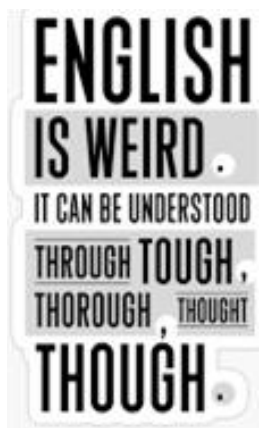
From: https://images.app.goo.gl/dCFurjmcnZzU7AHS6
Text I
The BNCC and Twenty-First Century Skills
The most ambitious feature of the BNCC, which only appeared in the document’s third version, was to establish ten core competencies that all students should develop throughout basic education, starting in early childhood. These competencies include lifelong learning, critical thinking, aesthetic sensibilities, communication skills, digital literacy, entrepreneurship, self-care, empathy, citizenship and ethics. The core competencies broaden the goals of basic education well-beyond academic skills to twenty-first century skills widely regarded as essential to preparing the next generations for the challenges of the 4th industrial revolution.
As ambitious as it was, the BNCC was criticized for the lack of explicit links between the ten core competencies and the subject specific competencies and skills, leaving cities and states with the responsibility of making these links themselves. In addition to this, the core competencies are not generally integrated into teacher training programs and are often de-prioritized for the more basic literacy and numeracy needs. In this context, the Ministry of Education and its partners in the third sector have developed orientations, produced videos and online courses aimed at filling this gap, and helped cities and states integrate the ten core competencies in their curricula.
[…]
Ensuring all Brazilian students master the ten core competencies laid out by the BNCC by the end of high school is a long-term, extremely ambitious goal. Before we can set a timeframe for when we will be able to achieve this feat, we need to know where we stand. Due to the core competencies’ complexity, each involves several skills, attitudes and sometimes values, it is unclear whether we will be capable of measuring all ten of them and by when. Until then we are in the company of the OECD, which is already tackling this challenge and will likely pave the way for Brazil in this respect
Note: BNCC: Base Nacional Comum Curricular;
OECD: The Organization for Economic Cooperation and Development.
Adapted from https://link.springer.com/chapter/10.1007/978-3-030-41882-3_2
Text I
The BNCC and Twenty-First Century Skills
The most ambitious feature of the BNCC, which only appeared in the document’s third version, was to establish ten core competencies that all students should develop throughout basic education, starting in early childhood. These competencies include lifelong learning, critical thinking, aesthetic sensibilities, communication skills, digital literacy, entrepreneurship, self-care, empathy, citizenship and ethics. The core competencies broaden the goals of basic education well-beyond academic skills to twenty-first century skills widely regarded as essential to preparing the next generations for the challenges of the 4th industrial revolution.
As ambitious as it was, the BNCC was criticized for the lack of explicit links between the ten core competencies and the subject specific competencies and skills, leaving cities and states with the responsibility of making these links themselves. In addition to this, the core competencies are not generally integrated into teacher training programs and are often de-prioritized for the more basic literacy and numeracy needs. In this context, the Ministry of Education and its partners in the third sector have developed orientations, produced videos and online courses aimed at filling this gap, and helped cities and states integrate the ten core competencies in their curricula.
[…]
Ensuring all Brazilian students master the ten core competencies laid out by the BNCC by the end of high school is a long-term, extremely ambitious goal. Before we can set a timeframe for when we will be able to achieve this feat, we need to know where we stand. Due to the core competencies’ complexity, each involves several skills, attitudes and sometimes values, it is unclear whether we will be capable of measuring all ten of them and by when. Until then we are in the company of the OECD, which is already tackling this challenge and will likely pave the way for Brazil in this respect
Note: BNCC: Base Nacional Comum Curricular;
OECD: The Organization for Economic Cooperation and Development.
Adapted from https://link.springer.com/chapter/10.1007/978-3-030-41882-3_2
Text I
The BNCC and Twenty-First Century Skills
The most ambitious feature of the BNCC, which only appeared in the document’s third version, was to establish ten core competencies that all students should develop throughout basic education, starting in early childhood. These competencies include lifelong learning, critical thinking, aesthetic sensibilities, communication skills, digital literacy, entrepreneurship, self-care, empathy, citizenship and ethics. The core competencies broaden the goals of basic education well-beyond academic skills to twenty-first century skills widely regarded as essential to preparing the next generations for the challenges of the 4th industrial revolution.
As ambitious as it was, the BNCC was criticized for the lack of explicit links between the ten core competencies and the subject specific competencies and skills, leaving cities and states with the responsibility of making these links themselves. In addition to this, the core competencies are not generally integrated into teacher training programs and are often de-prioritized for the more basic literacy and numeracy needs. In this context, the Ministry of Education and its partners in the third sector have developed orientations, produced videos and online courses aimed at filling this gap, and helped cities and states integrate the ten core competencies in their curricula.
[…]
Ensuring all Brazilian students master the ten core competencies laid out by the BNCC by the end of high school is a long-term, extremely ambitious goal. Before we can set a timeframe for when we will be able to achieve this feat, we need to know where we stand. Due to the core competencies’ complexity, each involves several skills, attitudes and sometimes values, it is unclear whether we will be capable of measuring all ten of them and by when. Until then we are in the company of the OECD, which is already tackling this challenge and will likely pave the way for Brazil in this respect
Note: BNCC: Base Nacional Comum Curricular;
OECD: The Organization for Economic Cooperation and Development.
Adapted from https://link.springer.com/chapter/10.1007/978-3-030-41882-3_2
Text I
The BNCC and Twenty-First Century Skills
The most ambitious feature of the BNCC, which only appeared in the document’s third version, was to establish ten core competencies that all students should develop throughout basic education, starting in early childhood. These competencies include lifelong learning, critical thinking, aesthetic sensibilities, communication skills, digital literacy, entrepreneurship, self-care, empathy, citizenship and ethics. The core competencies broaden the goals of basic education well-beyond academic skills to twenty-first century skills widely regarded as essential to preparing the next generations for the challenges of the 4th industrial revolution.
As ambitious as it was, the BNCC was criticized for the lack of explicit links between the ten core competencies and the subject specific competencies and skills, leaving cities and states with the responsibility of making these links themselves. In addition to this, the core competencies are not generally integrated into teacher training programs and are often de-prioritized for the more basic literacy and numeracy needs. In this context, the Ministry of Education and its partners in the third sector have developed orientations, produced videos and online courses aimed at filling this gap, and helped cities and states integrate the ten core competencies in their curricula.
[…]
Ensuring all Brazilian students master the ten core competencies laid out by the BNCC by the end of high school is a long-term, extremely ambitious goal. Before we can set a timeframe for when we will be able to achieve this feat, we need to know where we stand. Due to the core competencies’ complexity, each involves several skills, attitudes and sometimes values, it is unclear whether we will be capable of measuring all ten of them and by when. Until then we are in the company of the OECD, which is already tackling this challenge and will likely pave the way for Brazil in this respect
Note: BNCC: Base Nacional Comum Curricular;
OECD: The Organization for Economic Cooperation and Development.
Adapted from https://link.springer.com/chapter/10.1007/978-3-030-41882-3_2
Text I
The BNCC and Twenty-First Century Skills
The most ambitious feature of the BNCC, which only appeared in the document’s third version, was to establish ten core competencies that all students should develop throughout basic education, starting in early childhood. These competencies include lifelong learning, critical thinking, aesthetic sensibilities, communication skills, digital literacy, entrepreneurship, self-care, empathy, citizenship and ethics. The core competencies broaden the goals of basic education well-beyond academic skills to twenty-first century skills widely regarded as essential to preparing the next generations for the challenges of the 4th industrial revolution.
As ambitious as it was, the BNCC was criticized for the lack of explicit links between the ten core competencies and the subject specific competencies and skills, leaving cities and states with the responsibility of making these links themselves. In addition to this, the core competencies are not generally integrated into teacher training programs and are often de-prioritized for the more basic literacy and numeracy needs. In this context, the Ministry of Education and its partners in the third sector have developed orientations, produced videos and online courses aimed at filling this gap, and helped cities and states integrate the ten core competencies in their curricula.
[…]
Ensuring all Brazilian students master the ten core competencies laid out by the BNCC by the end of high school is a long-term, extremely ambitious goal. Before we can set a timeframe for when we will be able to achieve this feat, we need to know where we stand. Due to the core competencies’ complexity, each involves several skills, attitudes and sometimes values, it is unclear whether we will be capable of measuring all ten of them and by when. Until then we are in the company of the OECD, which is already tackling this challenge and will likely pave the way for Brazil in this respect
Note: BNCC: Base Nacional Comum Curricular;
OECD: The Organization for Economic Cooperation and Development.
Adapted from https://link.springer.com/chapter/10.1007/978-3-030-41882-3_2
I. Teacher education programs today focus more on the ten core competencies than on other needs the students may have. II. The BNCC has been the object of some resistance. III. Core competencies can now be measured in a simple way.
Choose the correct answer:
Text I
The BNCC and Twenty-First Century Skills
The most ambitious feature of the BNCC, which only appeared in the document’s third version, was to establish ten core competencies that all students should develop throughout basic education, starting in early childhood. These competencies include lifelong learning, critical thinking, aesthetic sensibilities, communication skills, digital literacy, entrepreneurship, self-care, empathy, citizenship and ethics. The core competencies broaden the goals of basic education well-beyond academic skills to twenty-first century skills widely regarded as essential to preparing the next generations for the challenges of the 4th industrial revolution.
As ambitious as it was, the BNCC was criticized for the lack of explicit links between the ten core competencies and the subject specific competencies and skills, leaving cities and states with the responsibility of making these links themselves. In addition to this, the core competencies are not generally integrated into teacher training programs and are often de-prioritized for the more basic literacy and numeracy needs. In this context, the Ministry of Education and its partners in the third sector have developed orientations, produced videos and online courses aimed at filling this gap, and helped cities and states integrate the ten core competencies in their curricula.
[…]
Ensuring all Brazilian students master the ten core competencies laid out by the BNCC by the end of high school is a long-term, extremely ambitious goal. Before we can set a timeframe for when we will be able to achieve this feat, we need to know where we stand. Due to the core competencies’ complexity, each involves several skills, attitudes and sometimes values, it is unclear whether we will be capable of measuring all ten of them and by when. Until then we are in the company of the OECD, which is already tackling this challenge and will likely pave the way for Brazil in this respect
Note: BNCC: Base Nacional Comum Curricular;
OECD: The Organization for Economic Cooperation and Development.
Adapted from https://link.springer.com/chapter/10.1007/978-3-030-41882-3_2
Text I
The BNCC and Twenty-First Century Skills
The most ambitious feature of the BNCC, which only appeared in the document’s third version, was to establish ten core competencies that all students should develop throughout basic education, starting in early childhood. These competencies include lifelong learning, critical thinking, aesthetic sensibilities, communication skills, digital literacy, entrepreneurship, self-care, empathy, citizenship and ethics. The core competencies broaden the goals of basic education well-beyond academic skills to twenty-first century skills widely regarded as essential to preparing the next generations for the challenges of the 4th industrial revolution.
As ambitious as it was, the BNCC was criticized for the lack of explicit links between the ten core competencies and the subject specific competencies and skills, leaving cities and states with the responsibility of making these links themselves. In addition to this, the core competencies are not generally integrated into teacher training programs and are often de-prioritized for the more basic literacy and numeracy needs. In this context, the Ministry of Education and its partners in the third sector have developed orientations, produced videos and online courses aimed at filling this gap, and helped cities and states integrate the ten core competencies in their curricula.
[…]
Ensuring all Brazilian students master the ten core competencies laid out by the BNCC by the end of high school is a long-term, extremely ambitious goal. Before we can set a timeframe for when we will be able to achieve this feat, we need to know where we stand. Due to the core competencies’ complexity, each involves several skills, attitudes and sometimes values, it is unclear whether we will be capable of measuring all ten of them and by when. Until then we are in the company of the OECD, which is already tackling this challenge and will likely pave the way for Brazil in this respect
Note: BNCC: Base Nacional Comum Curricular;
OECD: The Organization for Economic Cooperation and Development.
Adapted from https://link.springer.com/chapter/10.1007/978-3-030-41882-3_2
( ) The core competencies are not solely restricted to academic skills. ( ) Mastering the ten core competencies by the end of high school can be easily achieved. ( ) The core competencies established by the BNCC for basic education were a later development.
The statements are, respectively:
Observe a imagem a seguir:

Fonte: https://brasil.elpais.com/brasil/2015/01 /07/album/1420632020_829679.html#foto_gal_3
A imagem é a capa da revista Charlie Hebdo, edição seguinte ao ataque terrorista sofrido pela sede da edição em 2015, em Paris. Ela apresenta um homem com vestimentas muçulmanas e um cartunista com a camisa escrita “Charlie Hebdo” se beijando. Seu título é “O amor é mais forte que o ódio” em português.
É possível relacionar os ataques terroristas à França com as políticas internacionais do país relacionadas ao Oriente Médio. Assinale a afirmativa que descreve corretamente uma das atuações francesas sobre a região.
Observe a imagem a seguir:
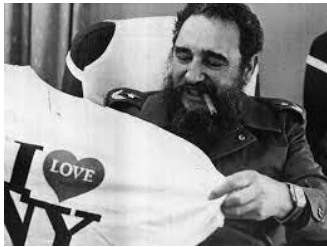
Fonte:https://elpais.com/cultura/2015/10/08/actualidad/1444316985_737930.html
A foto retrata Fidel Castro, em sua visita à cidade de Nova Iorque, Estados Unidos, segurando uma camisa que contém o seguinte escrito “I love NY” que significa “Eu amo Nova Iorque” em português.
A respeito das relações políticas entre Cuba e Estados Unidos, assinale a afirmativa que descreve corretamente um dos motivos que resultou no afastamento entre os dois países após a Revolução de 1959.
Adaptado de: CUETO, Marcos. La “cultura de la sobrevivência” y la salud pública internacional en América Latina: la Guerra Fría y la erradicación de enfermedades a mediados del siglo XX. História, Ciências, Saúde – Manguinhos, Rio de Janeiro, v.22, n.1, jan.-mar. 2015, p.257.
As afirmativas a seguir apresentam corretamente fatores da atuação sanitária dos Estados Unidos, à exceção de uma. Assinale-a.
1. Governo Castelo Branco 2. Governo Costa e Silva 3. Governo Emílio Médici
( ) Criou o Programa de Integração Nacional (PIN) com o objetivo de ocupar e integrar partes da região norte e utilizou o lema “Brasil: ame-o ou deixo-o” como propaganda política patriótica. ( ) Instaurou o Ato Institucional número 5 como ferramenta para intimidar os opositores do governo, intensificando os instrumentos de repressão, e criou a Fundação Nacional do Índio (FUNAI). ( ) Formou Serviço Nacional de Informações (SNI) com o objetivo de controlar informações que interessavam a Segurança Nacional, e foi durante seu governo que o Banco Central foi criado.
Assinale a afirmativa que apresenta a relação correta, na ordem apresentada.
( ) O movimento de aspirações socialistas foi abafado pelo governo salazarista que intensificou suas atividades após a derrota do movimento. ( ) O movimento teve como centro de suas críticas a atuação militar que repreendeu os manifestantes durante os protestos nas regiões urbanas. ( ) O movimento apoiou a independência das possessões portuguesas no continente africano.
A respeito do movimento, está correto o que se afirma em
Observe as duas imagens a seguir:
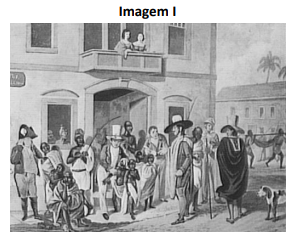
Fonte: Mercado de Escravos no Rio de Janeiro. In: ENCICLOPÉDIA Itaú Cultural de Arte e Cultura Brasileira. São Paulo: Itaú Cultural, 2023. Disponível em: http://enciclopedia.itaucultural.org.br/obra9872/mercado-de-escravos-no-rio-dejaneiro.
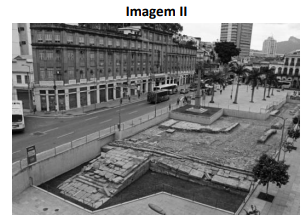
Fonte: https://www.gov.br/palmares/pt-br/assuntos/noticias/cais-do-valongoganha-titulo-de-patrimonio-mundial-da-unesco
A imagem I retrata o Mercado de escravos na cidade do Rio de Janeiro no século XIX. Na cena pintada por Augustus Earle em 1824, estão representados homens em vestimentas próprias das classes abastadas e homens afrodescendentes despidos ou semidespidos em condição de cativo sendo comercializados. A imagem II é uma fotografia atual da mesma região da imagem I, que é o Sitio Arqueológico do Cais do Valongo, onde contém vestígios materiais da presença de afrodescentes escravizados na cidade carioca.
A análise das duas imagens em perspectiva comparada foi proposta por um docente como atividade didática sobre a escravidão, tendo o uso histórico dos espaços urbanos como objeto de estudo.
A respeito dessa atividade, avalie se as afirmativas a seguir são verdadeiras (V) ou falsas (F).
( ) Promove estudos e reflexões sobre a presença na atualidade de elementos materiais e mentais de outros tempos e incentivar reflexões sobre as relações entre presente e passado, entre espaços locais, regionais, nacionais e mundiais;
( ) Promove estudos e reflexões sobre a diversidade de modos de vida e de costumes que convivem na mesma localidade;
( ) Propõe estudos das relações e reflexões que destaquem diferenças, semelhanças, transformações, permanências, continuidades e descontinuidades históricas. Assinale a afirmativa que apresenta a sequência correta, de cima para baixo.
Assinale a afirmativa que apresenta a sequência correta, de cima para baixo.
Observe a imagem a seguir:
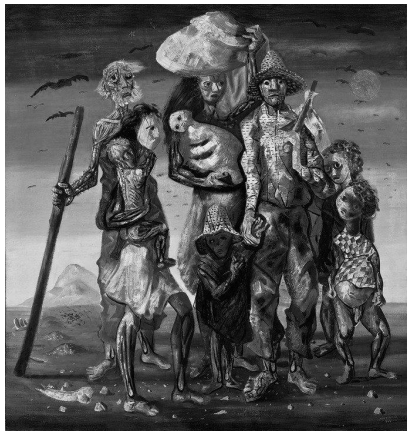
Fonte: Retirantes de Candido Portinari, São Paulo, 1944. https://masp.org.br/acervo/obra/retirantes-da-serie-retirantes-1944-1945
A pintura retrata uma família composta por 9 pessoas. Da esquerda para direita: um idoso e diante dele está uma mulher com um bebê no colo, ao seu lado uma outra mulher que também carrega um bebê, na parte direita da imagem encontra-se um homem com três crianças. Todas as pessoas representadas são magras, com vestimentas em mau estado de conservação e carregando trouxas.
Com base na representação, assinale a afirmativa que descreve corretamente um dos motivos que explicam os movimentos migratórios nordestinos durante o governo de Getúlio Vargas.
Observe a imagem a seguir:
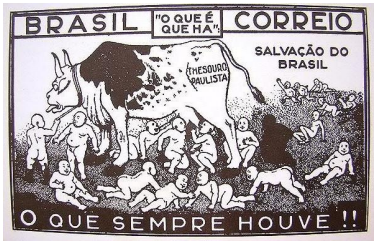
Fonte: https://www.bbc.com/portuguese/articles/cjmrxgmk9x4o
A imagem é uma propaganda da Revolução Constitucionalista de 1932. Nela estão representadas uma vaca com o escrito “Tesouro Paulista” em seu corpo e 19 crianças estabelecendo relações com o animal. Algumas a puxam, outras se alimentam de seu leite e outras convivem no mesmo cenário.
A respeito do movimento constitucionalista de 1932, assinale a afirmativa que descreve corretamente um dos seus objetivos.
Faz apenas cerca de um mês que escrevi minha última carta para vocês. Desde então acumulei tanto para contar que não sei como começar. Vi os jornais de Chicago de 6, 7, 8 e 9 de junho e eles podem dar uma ideia vaga e indefinida do que os fuzileiros navais fizeram durante todo o mês de junho. Para começar, ainda mantenho boa saúde, boa aparência e disposição feliz, embora não consiga entender como isso é possível. Ontem saímos das linhas (não das trincheiras) após 28 dias de inferno. Algum dia alguém contará a história como deveria ser contada. Como a Marinha enfrentou a retirada francesa, enfrentou os hunos embriagados com a vitória e os arremessou de volta. Estou convencido de que, se não fosse pelos fuzileiros navais dos Estados Unidos, Paris certamente teria sido tomada antes disso. Se eu pudesse transferir minha comissão do exército para o Corpo de Fuzileiros Navais, eu o faria. É uma honra servir com eles. As duas primeiras semanas foram horríveis. Fomos levados às pressas e as coisas estavam quentes desde o início. Não havia trincheiras, todos combates abertos em colinas, campos e florestas, como nossos avós lutaram em 61, mas agora com explosivos, estilhaços, metralhadoras e camaras de gás. As metralhadoras assumiram a liderança, indo aqui e ali, auxiliando um ataque e repelindo outro.
Adaptado de: Letter from Wayne to Folks; 7/1/1918; 3d Bn Replacements & Casualties June 18, 1918 Index Sheet 202 - 12.3; Records of Divisions, 1917 - 1920; Records of the American Expeditionary Forces (World War I), Record Group 120; National Archives at College Park, College Park, MD.
A leitura da carta elaborada por um soldado da Primeira Guerra Mundial foi proposta por um docente como atividade didática sobre o conflito.
A respeito dessa atividade, é possível afirmar que
I. Os novos impostos espoliavam a região de suas riquezas e diminuíam as rendas locais. Os senhores do Sul discordavam das altas taxas que recaíam sobre o gado, sobre a terra e principalmente sobre o charque. Começaria em 20 de setembro de 1835 um longo conflito contrário ao centralismo imperial, e de claro caráter separatista e republicano, que só terminaria em 1º de março de 1845, já nos tempos do Segundo Reinado brasileiro. Entre os revoltosos havia, pois, muitos segmentos irmanados: estancieiros, estancieiros militares, abolicionistas, e até escravos que se aproximaram do grupo em busca de liberdade.
Adaptado de: SCHWARCZ, Lilia; Starling, Heloisa. Brasil: uma biografia, São Paulo: Companhia das Letras, pp. 385-386.
II. Em 7 de janeiro de 1835, dia de são Tomé, liderados por Antônio Vinagre, os rebeldes tomaram o quartel e o palácio do governo de Belém, assassinando o presidente Lobo e Sousa e apoderando-se de grande material bélico. Ao mesmo tempo, nomearam um novo presidente do Grão-Pará: Félix Antônio Clemente Malcher, que se encontrava até então preso por conta de sua atuação considerada contrária ao regime. Mas o fato é que, quanto mais o movimento se radicalizava, maior era a autonomia lograda por negros e indígenas, bem como crescia o papel dos líderes africanos.
Adaptado de: SCHWARCZ, Lilia; Starling, Heloisa. Brasil: uma biografia, São Paulo: Companhia das Letras, pp. 371 – 372
A partir da leitura das descrições, assinale a afirmativa que apresenta corretamente os nomes dos conflitos que ocorreram durante o período regencial.
Adaptado de: HERZOG, Tamar. Fronteiras da Posse. Portugal e Espanha na Europa e na América. Lisboa: Imprensa de Ciências Sociais, 2018, p. 134.
Com base no trecho, as delimitações fronteiriças na América colonial incorporaram